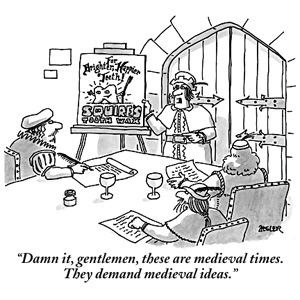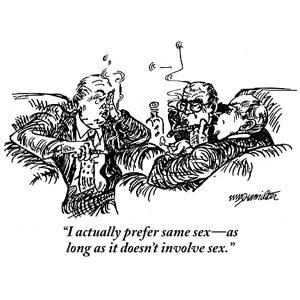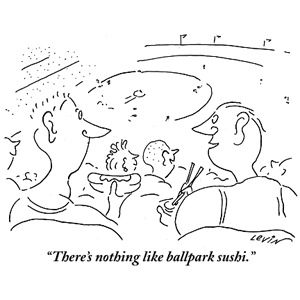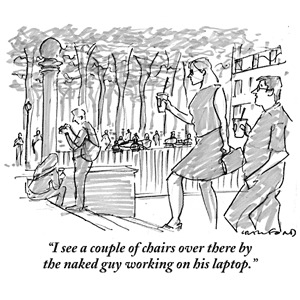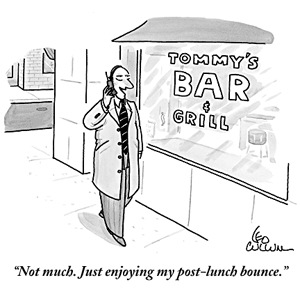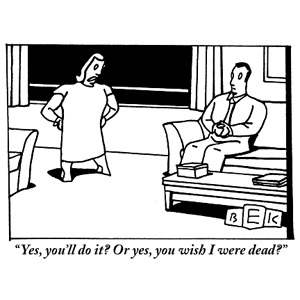American Chronicles
The Lie Factory
How politics became a business.
by Jill Lepore September 24, 2012

The field of political consulting was unknown before Leone Baxter and Clem Whitaker founded Campaigns, Inc., in 1933.
“I, Governor of California, and
How I Ended Poverty,” by Upton Sinclair, is probably the most thrilling
piece of campaign literature ever written. Instead of the usual
flummery, Sinclair, the author of forty-seven books, including, most
famously, “The Jungle,” wrote a work of fiction. “I, Governor of
California,” published in 1933, announced Sinclair’s gubernatorial bid
in the form of a history of the future, in which Sinclair is elected
governor in 1934, and by 1938 has eradicated poverty. “So far as I
know,” the author remarked, “this is the first time an historian has set
out to make his history true.”
The pace really picks up after Sinclair adopts an acronymic campaign slogan, “END POVERTY IN CALIFORNIA” (“It was pointed out that the initials of these words spell ‘EPIC’ ”); picks a campaign emblem, passing over the eagle and the hawk (“I personally can get up no enthusiasm for any kind of bird of prey,” the candidate says) in favor of the busy bee (“she not only works hard but has means to defend herself”); explains a program of coöperative factories and farms that would implement his philosophy of “production for use” rather than for profit; proposes killing the sales tax while levying something like a thirty-per-cent income tax on anyone earning more than fifty thousand dollars a year; and promises not only to raise hell but also, preposterously, to win.
All the same, it was a shock to pretty much everyone that, in August of 1934, Sinclair won the Democratic nomination, with more votes than any primary candidate in California had ever won before. That happens in the novel, too, which is what made reading it so thrilling (or, for many people, so terrifying): watching what Sinclair imagined coming to pass. Chapter 4: “The news that the Democratic voters of California had committed their party to the EPIC plan caused a sensation throughout the country.” True! “It resulted in wide discussion of the plan in the magazines, and the formation of an EPIC Committee for the Nation.” Sort of! “A statement endorsing Sinclair for Governor was signed by a hundred leading writers, and college groups were formed everywhere throughout the country to recommend the plan for their cities and states. A group of forward-looking economists endorsed the plan, and letters of support were received from a score of United States senators and some fifty congressmen.” O.K., that part never happened.
In 1934, Sinclair explained what did happen that election year, in a nonfiction sequel called “I, Candidate for Governor, and How I Got Licked.” “When I was a boy, the President of Harvard University wrote about ‘the scholar in politics,’ ” Sinclair began. “Here is set forth how a scholar went into politics, and what happened to him.” “How I Got Licked” was published in daily installments in fifty newspapers. In it, Sinclair described how, immediately after the Democratic Convention, the Los Angeles Times began running on its front page a box with an Upton Sinclair quotation in it, a practice that the paper continued, every day, for six weeks, until the opening of the polls. “Reading these boxes day after day,” Sinclair wrote, “I made up my mind that the election was lost.”
Sinclair got licked, he said, because the opposition ran what he called a Lie Factory. “I was told they had a dozen men searching the libraries and reading every word I had ever published.” They’d find lines he’d written, speeches of fictional characters in novels, and stick them in the paper, as if Sinclair had said them. “They had a staff of political chemists at work, preparing poisons to be let loose in the California atmosphere on every one of a hundred mornings.” Actually, they had, at the time, a staff of only two, and the company wasn’t called the Lie Factory. It was called Campaigns, Inc.
Campaigns, Inc., the first
political-consulting firm in the history of the world, was founded, in
1933, by Clem Whitaker and Leone Baxter. Whitaker, thirty-four, had
started out as a newspaperman, or, really, a newspaper boy; he was
working as a reporter at the age of thirteen. By nineteen, he was city
editor for the Sacramento Union and, a couple of years later, a political writer for the San Francisco Examiner.
He was friendly and gangly, and had big ears, and smoked, and never
stopped talking, and typed with two fingers. He started a newspaper wire
service, the Capitol News Bureau, distributing stories to eighty
papers. In 1930, he sold that business to the United Press. Three years
later, he was, for his political ingenuity, hired by, among others,
Sheridan Downey, a prominent Democrat, to help defeat a referendum
sponsored by Pacific Gas and Electric. Downey also hired Baxter, a
twenty-six-year-old widow who had been a writer for the Portland Oregonian, and suggested that she and Whitaker join forces.
Baxter was small, fine-featured, red-headed, and
elegant. “Oh, he was such a dear,” she would say, about someone she
liked. Whitaker’s suits never looked like they fit him; Baxter’s looked
like they’d fit Audrey Hepburn. Whitaker and Baxter started doing
business as Campaigns, Inc. The referendum was defeated. Whitaker
separated from his wife. In 1938, he and Baxter married. They lived in
Marin County, in a house with a heated swimming pool. They began every
day with a two-hour breakfast to plan the day. She sometimes called him
Clem; he only ever called her Baxter.
In 1934, when Sinclair won the Democratic nomination, he chose Downey as his running mate. (“Uppie and Downey,” the ticket was called.) Working for Downey had been an aberration for Whitaker and Baxter, people who, it was said, “work the Right side of the street.” Campaigns, Inc., specialized in running political campaigns for businesses, especially monopolies like Standard Oil and Pacific Telephone and Telegraph. Pacific Gas and Electric was so impressed that it put Campaigns, Inc., on retainer.
Political consulting is often thought of as an offshoot of the advertising industry, but closer to the truth is that the advertising industry began as a form of political consulting. As the political scientist Stanley Kelley once explained, when modern advertising began, the big clients were just as interested in advancing a political agenda as a commercial one. Monopolies like Standard Oil and DuPont looked bad: they looked greedy and ruthless and, in the case of DuPont, which made munitions, sinister. They therefore hired advertising firms to sell the public on the idea of the large corporation, and, not incidentally, to advance pro-business legislation. It’s this kind of thing that Sinclair was talking about when he said that American history was a battle between business and democracy, and, “So far,” he wrote, “Big Business has won every skirmish.”
Like most California Republicans, Clem Whitaker and Leone Baxter, who headed the California League Against Sinclairism, were horrified at the prospect of Sinclair in the governor’s office. They had to work fast. They were hired just two months before the election by George Hatfield, the candidate for lieutenant governor on a Republican ticket headed by the incumbent governor, Frank Merriam, but, mostly, they were hired to destroy Sinclair. They began by locking themselves in a room for three days with everything he had ever written. “Upton was beaten,” Whitaker later said, “because he had written books.” And, so, those boxes in the L.A. Times:
SINCLAIR ON MARRIAGE:
The sanctity of marriage. . . . I have had such a belief . . . I have it no longer.
The
excerpt, as Sinclair explained in “How I Got Licked,” was taken from a
passage in his 1911 novel, “Love’s Pilgrimage,” in which one character
writes a heartbroken letter to a man having an affair with his wife.
(The novel, which Sinclair later found greatly embarrassing, is an
autobiographical account of his disastrous first marriage, which ended
in 1912 when, citing his wife’s adultery, he divorced her; he married
his second wife in 1913; their marriage lasted until her death, in
1961.) “Sure, those quotations were irrelevant,” Baxter later said. “But
we had one objective: to keep him from becoming Governor.”
Sinclair lost. He probably would have been a terrible governor. That, though, wasn’t really what was at stake.
In 1934, Upton Sinclair got licked, but a great
many End Poverty in California candidates got elected, as Democrats.
California became a two-party state. Twenty-four EPIC
candidates, among them a Los Angeles lawyer named Culbert Olson, took
their seats in the state legislature, and, four years later, Olson, the
leader of the state’s EPIC caucus, was elected governor.
Olson named Carey McWilliams, a Los Angeles attorney, writer, and
reporter, as his chief of the California State Division of Immigration
and Housing.
In 1938, McWilliams, a friend of Sinclair’s, had campaigned for Olson while writing “Factories in the Field: The Story of Migratory Farm Labor in California.” It reads like a nonfiction version of “The Grapes of Wrath.” Both books were published in 1939. Steinbeck’s was banned, and Republicans in the state legislature attempted to abolish the Division of Immigration and Housing, just to get McWilliams fired.
In 1942, Republicans backing the state’s attorney general, Earl Warren, in a bid to replace Olson in the governor’s office urged him to hire Whitaker and Baxter to run his campaign. Warren agreed, somewhat reluctantly. In the years since defeating Sinclairism, Whitaker and Baxter had put a few more items in their campaign tool kit. In 1939, with pamphlets like “Hoaxing the Hungry,” Campaigns, Inc., had led the effort to defeat California’s Proposition 1, the “Ham and Eggs” referendum, which would have instituted a three-per-cent income tax to provide a thirty-dollar-a-week pension to every citizen over fifty: ham and eggs every Thursday. (Harper’s later reported, “In a typical campaign they employed ten million pamphlets and leaf-lets; 50,000 letters to ‘key individuals and officers of organizations’; 70,000 inches of advertising in 700 newspapers; 3,000 spot announcements on 109 radio stations; theater slides and trailers in 160 theaters; 1,000 large billboards and 18,000 or 20,000 smaller posters.”) In 1940, they produced materials for the Republican Wendell Willkie’s Presidential campaign, including a speaker’s manual that offered advice about how to handle Democrats in the audience: “rather than refer to the opponent as the ‘Democratic Party’ or ‘New Deal Administration’ refer to the Candidate by name only.”
In 1934, when Sinclair won the Democratic nomination, he chose Downey as his running mate. (“Uppie and Downey,” the ticket was called.) Working for Downey had been an aberration for Whitaker and Baxter, people who, it was said, “work the Right side of the street.” Campaigns, Inc., specialized in running political campaigns for businesses, especially monopolies like Standard Oil and Pacific Telephone and Telegraph. Pacific Gas and Electric was so impressed that it put Campaigns, Inc., on retainer.
Political consulting is often thought of as an offshoot of the advertising industry, but closer to the truth is that the advertising industry began as a form of political consulting. As the political scientist Stanley Kelley once explained, when modern advertising began, the big clients were just as interested in advancing a political agenda as a commercial one. Monopolies like Standard Oil and DuPont looked bad: they looked greedy and ruthless and, in the case of DuPont, which made munitions, sinister. They therefore hired advertising firms to sell the public on the idea of the large corporation, and, not incidentally, to advance pro-business legislation. It’s this kind of thing that Sinclair was talking about when he said that American history was a battle between business and democracy, and, “So far,” he wrote, “Big Business has won every skirmish.”
Like most California Republicans, Clem Whitaker and Leone Baxter, who headed the California League Against Sinclairism, were horrified at the prospect of Sinclair in the governor’s office. They had to work fast. They were hired just two months before the election by George Hatfield, the candidate for lieutenant governor on a Republican ticket headed by the incumbent governor, Frank Merriam, but, mostly, they were hired to destroy Sinclair. They began by locking themselves in a room for three days with everything he had ever written. “Upton was beaten,” Whitaker later said, “because he had written books.” And, so, those boxes in the L.A. Times:
SINCLAIR ON MARRIAGE:
The sanctity of marriage. . . . I have had such a belief . . . I have it no longer.
Sinclair lost. He probably would have been a terrible governor. That, though, wasn’t really what was at stake.
No
single development has altered the workings of American democracy in
the last century so much as political consulting, an industry unknown
before Campaigns, Inc. In the middle decades of the twentieth century,
political consultants replaced party bosses as the wielders of political
power gained not by votes but by money. Whitaker and Baxter were the
first people to make politics a business. “Every voter, a consumer” was
the mantra of a latter-day consulting firm, but that idea came from
Campaigns, Inc. Political management is now a diversified,
multibillion-dollar industry of managers, speechwriters, pollsters, and
advertisers who play a role in everything from this year’s Presidential
race to the campaigns of the candidates for your local school committee.
(Campaigns, now, never end. And consultants not only run campaigns;
they govern. Mitt Romney, asked by the Wall Street Journal’s
editorial board how he would choose his Cabinet, said that he’d probably
bring in McKinsey to sort that out.) But for years Whitaker and Baxter
had no competition, which is one reason that, between 1933 and 1955,
they won seventy out of seventy-five campaigns. The campaigns they chose
to run, and the way they decided to run them, shaped the history of
California, and of the country. Campaigns, Inc., is shaping American
politics still.
In 1938, McWilliams, a friend of Sinclair’s, had campaigned for Olson while writing “Factories in the Field: The Story of Migratory Farm Labor in California.” It reads like a nonfiction version of “The Grapes of Wrath.” Both books were published in 1939. Steinbeck’s was banned, and Republicans in the state legislature attempted to abolish the Division of Immigration and Housing, just to get McWilliams fired.
In 1942, Republicans backing the state’s attorney general, Earl Warren, in a bid to replace Olson in the governor’s office urged him to hire Whitaker and Baxter to run his campaign. Warren agreed, somewhat reluctantly. In the years since defeating Sinclairism, Whitaker and Baxter had put a few more items in their campaign tool kit. In 1939, with pamphlets like “Hoaxing the Hungry,” Campaigns, Inc., had led the effort to defeat California’s Proposition 1, the “Ham and Eggs” referendum, which would have instituted a three-per-cent income tax to provide a thirty-dollar-a-week pension to every citizen over fifty: ham and eggs every Thursday. (Harper’s later reported, “In a typical campaign they employed ten million pamphlets and leaf-lets; 50,000 letters to ‘key individuals and officers of organizations’; 70,000 inches of advertising in 700 newspapers; 3,000 spot announcements on 109 radio stations; theater slides and trailers in 160 theaters; 1,000 large billboards and 18,000 or 20,000 smaller posters.”) In 1940, they produced materials for the Republican Wendell Willkie’s Presidential campaign, including a speaker’s manual that offered advice about how to handle Democrats in the audience: “rather than refer to the opponent as the ‘Democratic Party’ or ‘New Deal Administration’ refer to the Candidate by name only.”
